托福综合写作范文真题解析
- 格式:docx
- 大小:51.76 KB
- 文档页数:5

新托福TPO综合写作详细解析汇总
在新托福综合写作中,有的同学语言使用的能力还有一定局限,还要刻意追求句式的复杂化,但这样的后果就是写出来的句子个个都有错,个个都有表达不清。
其实用最好的词表达最多的内容才是最厉害的写作方式,本文小编为大家整理了一篇新托福综合写作范文,来源于TPO 1—15。
新托福综合写作范文TPO2详细解析:团队的作用
新托福综合写作范文TPO3详细解析:伦勃朗
新托福综合写作范文TPO4详细解析:恒温动物
新托福综合写作范文TPO5详细解析:查科峡谷的巨屋
新托福综合写作范文TPO6详细解析:在线百科的利弊
新托福综合写作范文TPO7详细解析:环保认证在美国无用
新托福综合写作范文TPO8详细解析:塞恩加尔骑士
新托福综合写作范文TPO9详细解析:氢燃料
新托福综合写作范文TPO10详细解析:海獭数量减少的原因
新托福综合写作范文TPO11详细解析:人们不爱读书了
新托福综合写作范文TPO12详细解析:简·奥斯汀
新托福综合写作范文TPO13详细解析:私人化石买卖的坏处
新托福综合写作范文TPO14详细解析:回收性砍伐
新托福综合写作范文TPO15详细解析:控制蔗蜍数量的方法
新托福综合写作对语言的要求是清晰表达,准确转述即可(其实独立写作的要求也类似)。
没有必要一味地追求语言的华丽,把话说清楚最重要。
瑞德托福模考系统是专业的托福模拟考试软件、托福在线模拟考试软件,提供在线托福全真模考,系统可创建真实托福模考(TOEFL iBT)环境,按照阅读、听力、口语、写作四部分进行考试。
详情了解请登陆托福模考软件
托福模拟考试
在线学习平台:。
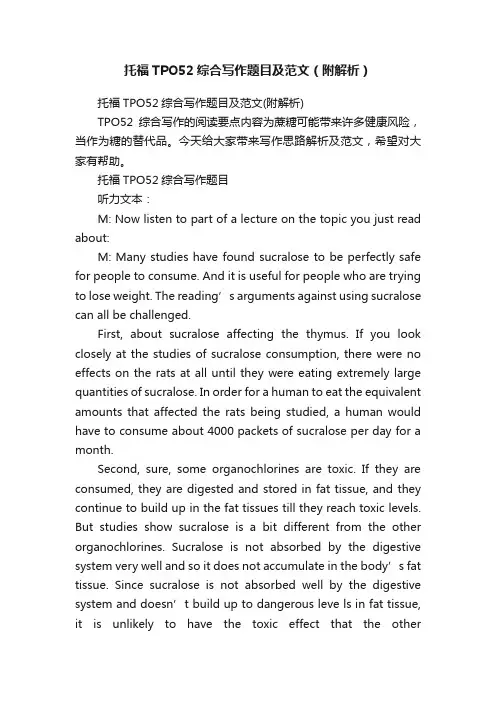
托福TPO52综合写作题目及范文(附解析)托福TPO52综合写作题目及范文(附解析)TPO52综合写作的阅读要点内容为蔗糖可能带来许多健康风险,当作为糖的替代品。
今天给大家带来写作思路解析及范文,希望对大家有帮助。
托福TPO52综合写作题目听力文本:M: Now listen to part of a lecture on the topic you just read about:M: Many studies have found sucralose to be perfectly safe for people to consume. And it is useful for people who are trying to lose weight. The reading’s arguments against using sucralose can all be challenged.First, about sucralose affecting the thymus. If you look closely at the studies of sucralose consumption, there were no effects on the rats at all until they were eating extremely large quantities of sucralose. In order for a human to eat the equivalent amounts that affected the rats being studied, a human would have to consume about 4000 packets of sucralose per day for a month.Second, sure, some organochlorines are toxic. If they are consumed, they are digested and stored in fat tissue, and they continue to build up in the fat tissues till they reach toxic levels. But studies show sucralose is a bit different from the other organochlorines. Sucralose is not absorbed by the digestive system very well and so it does not accumulate in the body’s fat tissue. Since sucralose is not absorbed well by the digestive system and doesn’t build up to dangerous leve ls in fat tissue, it is unlikely to have the toxic effect that the otherorganochlorines do.Finally, there is the argument that many people who use artificial sweeteners in their drinks end up eating lots of real sugar in food like cake, and so they negate the benefits of using the sweetener. Well, that argument may hold true for many artificial sweeteners but sucralose has a unique property that makes it different. Most artificial sweeteners breakdown if they are heated too much, but sucralose does not break down when heated. That means that unlike other sweeteners, sucralose can be used to bake things, like cakes and cookies, for example. People craving something sweet can turn to cakes or cookies baked with sucralose, which helps them keep their diets on track.M: Summarize the points made in the lecture, being sure to explain how they challenge the specific points made in the reading passage.阅读文本:ReadingSucralose is an artificial sweetener that is used in place of natural sugar. Many people use sucralose as a substitute for sugar to control their weight. However, there may be several health risks associated with sucralose. Also, it is not clear whether sucralose actually helps people lose weight.First, researchers in Australia did studies on rats and discovered that sucralose consumption caused shrinking of the thymus in rats. The thymus is an organ that is crucial to maintaining a healthy immune system; in humans it is particularly active in childhood. If sucralose has similar effects on humans, then long-term use of sucralose could cause harm to the immune system, especially in children.Second, sucralose is created by replacing some of the atoms in natural sugar molecules with chlorine. This means sucralose belongs to a group of chemicals called organochlorines, which is another cause for concern. Organochlorines are known to be toxic to plants and animals, including humans. Some organochlorines are even used as pesticides. Sucralose is chemically similar to these toxic chemicals, so there may be a risk of poisoning if sucralose builds up in human body tissue (in fat tissue, for example).Third, substituting artificial sweeteners for real sugar in coffee, tea, and soft drinks often does not help people lose weight, since it reinforces the habit of enjoying sweet food. When people use artificial sweeteners in their drinks, their appetite for sugar remains strong, and they satisfy their sweetness cravings by eating greater portions of foods containing real sugar, such as cakes or cookies. Such eating habits can prevent them from achieving their goal of losing weight.Summarize the points made in the lecture, being sure to explain how theysupport/contradict specific points made in the reading passage.答题思路:1. 阅读要点概括:Main point: Sucralose may bring about many health risks when used as a substitute for sugar.Sub point 1: Sucralose may cause harm to the immune system.Sub point 2: There may be a risk of poisoning if sucralose builds up in human body tissue.Sub point 3: Substituting artificial sweeteners for real sugar does not help people lose weight.2. 听力要点概括:Main point: Sucralose is perfectly safe for people to consume.Sub point 1: It requires a consumption of extremely large quantities of sucralose to affect the thymus.Sub point 2: Sucralose does not accumulate in the body’s fat tissue so that it is unlikely to have the toxic effect.Sub point 3: People can use sucralose to replace sweet while keep their diets on track.范文:The sp eaker rebuts the reading’s arguments by debunking the exaggerated tested side effect on the human body, the hasty generalization that sucralose is proven toxic, and unwarranted claims that Sucralose can increase one’s sugar intake.The speaker begins by stating that Sucralose does affect the thymus, but only when the individual consumes a very large quantity of it, over 4000 packets per day. Despite the claim from the reading that sucralose might exert similar detrimental effects on a human thymus given the conclusive side effect has been witnessed in rats, the professor argues Sucralose can only pose a threat to one’s health under mass usage.Contrary to the belief in the passage that it belongs to a group of toxic chemicals called Organochlorines, Sucralose has been shown to act differently than traditional Organochlorines. The professor argues that people have a hard time fully digesting it and it does not build up in the body, therefore it is much less toxic. This directly challenges the fundamental theory in reading.Lastly, the professor casts doubt on the validity of the assumption that sucralose can encourage binge intakes of sweet food. The reading reasons that sucralose can build a growing reliance on sweetness, thus further d amaging one’s health.However, the speaker maintains that the very nature of Sucralose can endure a high heating temperature, thus serving as a perfect candidate to replace artificial sweeteners. In that sense any unfair concern over Sucralose being a gateway sugar inducer would be groundless.。
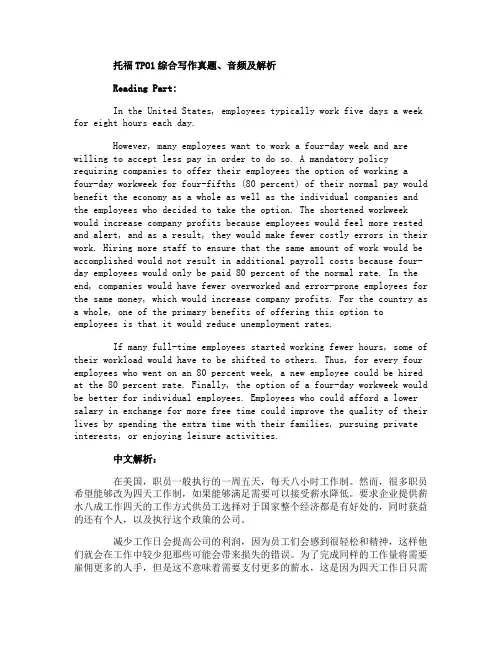
托福TPO1综合写作真题、音频及解析Reading Part:In the United States, employees typically work five days a week for eight hours each day.However, many employees want to work a four-day week and are willing to accept less pay in order to do so. A mandatory policy requiring companies to offer their employees the option of working a four-day workweek for four-fifths (80 percent) of their normal pay would benefit the economy as a whole as well as the individual companies and the employees who decided to take the option. The shortened workweek would increase company profits because employees would feel more rested and alert, and as a result, they would make fewer costly errors in their work. Hiring more staff to ensure that the same amount of work would be accomplished would not result in additional payroll costs because four-day employees would only be paid 80 percent of the normal rate. In the end, companies would have fewer overworked and error-prone employees for the same money, which would increase company profits. For the country as a whole, one of the primary benefits of offering this option to employees is that it would reduce unemployment rates.If many full-time employees started working fewer hours, some of their workload would have to be shifted to others. Thus, for every four employees who went on an 80 percent week, a new employee could be hired at the 80 percent rate. Finally, the option of a four-day workweek would be better for individual employees. Employees who could afford a lower salary in exchange for more free time could improve the quality of their lives by spending the extra time with their families, pursuing private interests, or enjoying leisure activities.中文解析:在美国,职员一般执行的一周五天,每天八小时工作制。
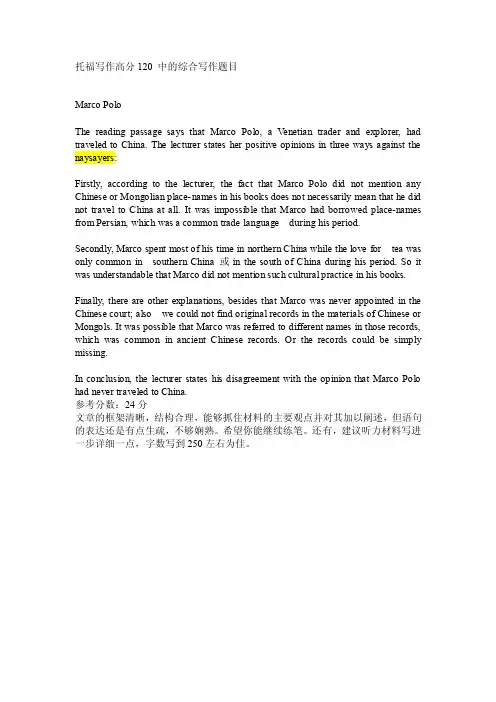
托福写作高分120 中的综合写作题目Marco PoloThe reading passage says that Marco Polo, a V enetian trader and explorer, had traveled to China. The lecturer states her positive opinions in three ways against the naysayers:Firstly, according to the lecturer, the fact that Marco Polo did not mention any Chinese or Mongolian place-names in his books does not necessarily mean that he did not travel to China at all. It was impossible that Marco had borrowed place-names from Persian, which was a common trade language during his period.Secondly, Marco spent most of his time in northern China while the love for tea was only common in southern China 或in the south of China during his period. So it was understandable that Marco did not mention such cultural practice in his books.Finally, there are other explanations, besides that Marco was never appointed in the Chinese court; also we could not find original records in the materials of Chinese or Mongols. It was possible that Marco was referred to different names in those records, which was common in ancient Chinese records. Or the records could be simply missing.In conclusion, the lecturer states his disagreement with the opinion that Marco Polo had never traveled to China.参考分数:24分文章的框架清晰,结构合理,能够抓住材料的主要观点并对其加以阐述,但语句的表达还是有点生疏,不够娴熟。

2024托福写作范文赏析整合在2024年的托福考试中,写作部分还是会是同样的难点。
为了让各位考生更好地备考,我们整合了以下几篇经典的范文,供大家参考学习。
1. 题目:Do you agree or disagree with the statement that self-driving cars will become the primary means of transportation in the future?范文:With the rapid development of technology, self-driving cars have become a well-talked topic around the world. Some people believe that self-driving cars will become the primary means of transportation in the future because of the advantages they bring. However, other people hold a different view. From my perspective, although self-driving cars have many advantages, they are unlikely to become the primary means of transportation in the future.First and foremost, self-driving cars still have some problems that need to be solved. For example, they cannot cope with extreme weather conditions or complex roadsituations. It is hard to imagine a self-driving car maneuvering through a flooded road or a narrow alley with alot of pedestrians and cyclists. Additionally, self-driving cars cannot replace all the functions of traditional cars.For some situations, such as off-road trips or extreme sports, traditional cars with manual control will still be theprimary choice.Moreover, the cost of self-driving cars is still high. At present, only a few people can afford to own a self-driving car, and the price of it will remain high for a long time. Therefore, self-driving cars will not become the primary means of transportation for most people, especially in developing countries.Last but not least, there are still many people who enjoy driving their cars. Driving on your own gives you a sense of control and freedom, and it is a joy that cannot be replacedby a machine. Even if self-driving cars become more prevalent in the future, there will always be people who prefer driving their own cars.In conclusion, self-driving cars have many advantages,but they are unlikely to become the primary means oftransportation in the future. They still have some problems that need to be solved, such as their inability to cope with extreme weather or complex road situations, and their high cost. Moreover, there are still many people who enjoy driving their cars. Therefore, we should not overestimate the importance of self-driving cars.2. 题目:Do you agree or disagree with the statement that advertisements are manipulative and should be banned?范文:Advertisements are an indispensable part of our daily lives. However, there is a growing concern that advertisements are manipulative and should be banned. From my perspective, I partially agree with the statement that advertisements are manipulative. However, I do not think that they should be banned completely.Firstly, advertisements are manipulative by nature. Advertisers use different techniques to present their products in the most appealing way, and they often exaggerate the benefits of their products while minimizing their drawbacks. This is understandable, as the goal ofadvertisements is to attract consumers and boost sales. However, this can also lead to unrealistic expectations and disappointment when the product does not live up to the advertisement.On the other hand, advertisements can also be informative and educational. Advertisements can provide valuable information about new products, services, or events. They can also raise awareness of social issues or health problems. For example, some public service announcements can be very effective in promoting safe driving, healthy lifestyle or environmental protection.Moreover, advertisements can also provide entertainment. Many commercials use humor, music, or other creative elements to capture our attention and evoke our emotion. They can be an enjoyable part of our daily lives and can even become a cultural phenomenon.In conclusion, advertisements are manipulative by nature, but they are not necessarily bad. They can be informative, educational, and entertaining. We should not ban advertisements completely, but we should also be aware of their manipulative nature and use critical thinking when weencounter them. As consumers, we should choose products wisely based on our own needs and preferences, instead of being swayed by advertisements.。

托福tpo 60综合写作范文一、阅读文章观点及理由。
阅读文章提出了一种观点,认为在公共图书馆放置电脑有很多弊端。
1. 干扰阅读氛围。
图书馆本应是安静阅读的地方。
电脑会发出各种声音,像按键声、提示音之类的。
人们在图书馆是想找个安静的角落沉浸在书的世界里,这些电脑的声音就像一个个小恶魔,打破了图书馆原有的宁静氛围,让那些想要好好读书的人不胜其烦。
2. 维护成本高。
电脑可不是个省心的家伙。
它需要定期更新软件,硬件要是出了毛病还得请专业人员来维修。
这可都是钱啊,图书馆的经费本来就有限,把钱花在这些电脑上,就会减少购买新书和其他资源的资金,这就像一个家庭本来打算买新衣服的钱,却拿去修那个总出故障的旧电器了。
3. 人们有其他上网途径。
现在这个时代,谁还缺个上网的地方呢?大家都有手机、平板电脑,家里也有电脑。
在公共图书馆设置电脑就有点多余了,就像在到处都是卖水的地方还非要在一个读书的地方摆个卖水的摊位一样。
二、听力文章观点及理由。
听力文章则对阅读文章的观点进行了反驳,认为在公共图书馆放置电脑是很有必要的。
1. 合理管理可避免干扰。
关于干扰阅读氛围这个事儿,其实很好解决。
图书馆可以专门划分出电脑区,就像把调皮捣蛋的孩子和认真学习的孩子分开一样。
在电脑区,大家可以自由使用电脑,而在阅读区,就还是安静的读书天堂。
而且,电脑也可以设置成静音模式,再加上现在的无线设备,很多操作都可以无声无息地进行。
这就好比把爱闹的小动物关进一个专门的小笼子,让它们在里面撒欢儿,却不影响其他动物休息。
2. 电脑带来新的资源和功能。
电脑虽然有维护成本,但是它带来的好处更多。
图书馆可以通过电脑提供电子书籍、在线数据库等资源。
这些资源可比单纯的纸质书丰富多了。
而且电脑还能提供一些特殊的功能,比如盲人可以使用电脑上的语音功能来听书。
这就像给图书馆这个知识宝库又开了几个新的大门,让更多的人可以用不同的方式获取知识,不能因为怕花钱就把这些好东西拒之门外啊。
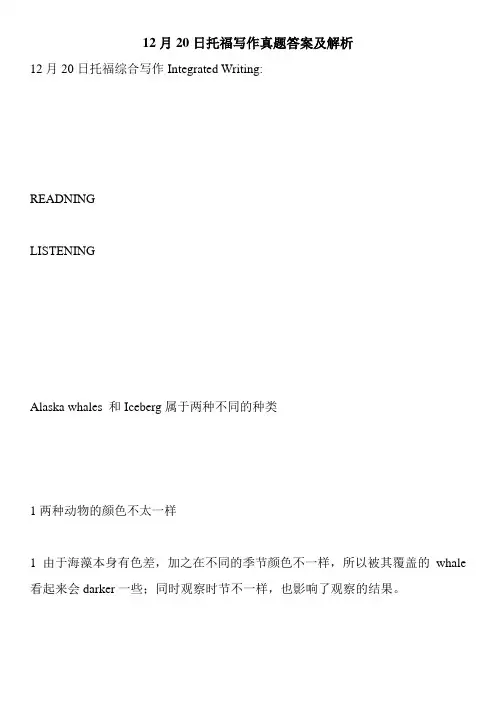
12月20日托福写作真题答案及解析12月20日托福综合写作Integrated Writing:READNINGLISTENINGAlaska whales 和Iceberg属于两种不同的种类1两种动物的颜色不太一样1 由于海藻本身有色差,加之在不同的季节颜色不一样,所以被其覆盖的whale 看起来会darker一些;同时观察时节不一样,也影响了观察的结果。
2 生存的水域不一样2 两种动物的饮食习惯不一样:一种喜欢吃mammals, 故原地不同;另一种喜欢吃fish,故被Russia海域的鱼吸引走了。
3 年龄不一样3 用fin测年龄不靠谱。
在20岁之后,fin就停止生长了。
所以,实际年龄会比估计的年龄大一些。
12月20日托福独立写作题目Independent Writing:Out of the following three things, which one would you prefer to regulate in order to improve your health? 2012.1.13NA/2012.11.2ML1. The kind of food you eat2. The amount of exercise3. The amount of stress in your lifeModern society has turned humans into curious creatures. Our ancestors were highly active thanks to their hunter-gatherer lifestyle; they ate fairly balanced diets due to the limited availability of fats and simple carbohydrates; and they relied on stress as a survival mechanism that kept them alert during intermittent periods of danger. Now, many of us spend upwards of 8 hours a day sedentary at our jobs; we eat unbalance diets of pre-prepared foods in order to save time; and we are constantly stressed due to a never-ending bombardment of stressors coming from our contemporary lifestyle. Managing all three things--diet, exercise, and stress--would be a daunting task for anyone, so if I had to pick one thing to improve my health, it would probably be exercise.To begin with, exercise is much easier to manage than both your diet and your stress. In order to manage your diet effectively, need to reduce or eliminate certain foods you enjoy eating, as well as create a comprehensive plan that balances your intake of different nutrients like proteins, fats, and carbohydrates. This is too much for most people, which explains the prevalence of “fad diets” that involve, for example, only eating a single type of food; these diets rarely ever work, and can even be dangerous. Managing stress is similarly difficult, because there are so many potential stressors to account for (work, kids, bills, etc.) and it may not be plausible to try and manage all ofthem. Exercise, on the other hand, can be effective even when simple. Take running: This exercise requires no forethought and can be done pretty much everywhere by pretty much everyone, yet carries a laundry list of health benefits ranging from boosting the immune system to lower the risk of breast cancer.Also, exercise has the scientifically measurable benefit of improving mood. When we perform physically demanding activities such as running, the brain releases a rush of endorphins that produces feelings of euphoria. From an evolutionary perspective, this is a neurological reward that encourages us to run and be healthy--we’r e basically built to be runners. If you can incorporate running (or some similar form of exercise) into your weekly routine, you’ll notice your mood improve almost immediately. And there’s also another, indirect way exercise improves mood: When you’re fit, you feel much better about yourself. I don’t just mean in the narcissistic way, either-- knowing that you’re exercising is just a good feeling.Lastly, and perhaps most importantly, exercise can lead to both better eating habits as well as lower overall stress. Exercise is in fact an excellent way to manage stress, and is recommended by medical authorities as a way to strengthen the brain’s buffers against it. It is even recommended by doctors for treating depression. This stress reduction from exercise can in turn lead to better food choices, since stress is an major contributor to poor eating habits, and eating healthy is much easier when you’re feeling good about yourself. Anyone who’s reached for junk-food during a stressful situation can tell you that.Obviously, diet, exercise, and stress management are all important for living a healthy life. However, if you had to choose only one, I’d say that exercise wins out when it comes to getting the most bang for your buck.。
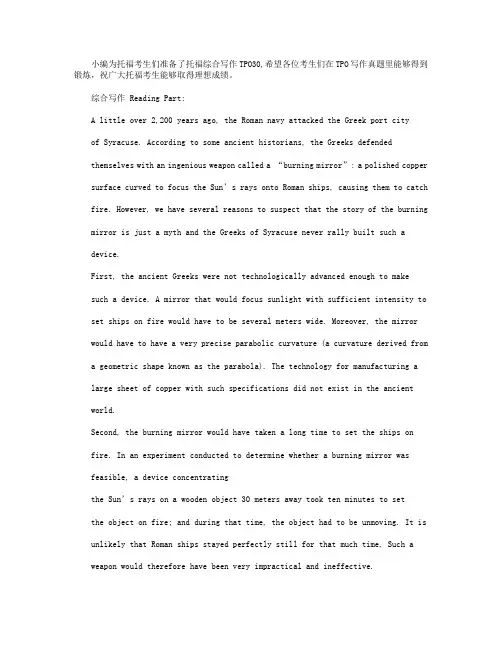
小编为托福考生们准备了托福综合写作TPO30,希望各位考生们在TPO写作真题里能够得到锻炼,祝广大托福考生能够取得理想成绩。
综合写作 Reading Part:A little over 2,200 years ago, the Roman navy attacked the Greek port cityof Syracuse. According to some ancient historians, the Greeks defendedthemselves with an ingenious weapon called a “burning mirror”: a polished coppersurface curved to focus the Sun’s rays onto Roman ships, causing them to catchfire. However, we have several reasons to suspect that the story of the burningmirror is just a myth and the Greeks of Syracuse never rally built such adevice.First, the ancient Greeks were not technologically advanced enough to makesuch a device. A mirror that would focus sunlight with sufficient intensity toset ships on fire would have to be several meters wide. Moreover, the mirrorwould have to have a very precise parabolic curvature (a curvature derived froma geometric shape known as the parabola). The technology for manufacturing alarge sheet of copper with such specifications did not exist in the ancientworld.Second, the burning mirror would have taken a long time to set the ships onfire. In an experiment conducted to determine whether a burning mirror wasfeasible, a device concentratingthe Sun’s rays on a wooden object 30 meters away took ten minutes to setthe object on fire; and during that time, the object had to be unmoving. It isunlikely that Roman ships stayed perfectly still for that much time, Such aweapon would therefore have been very impractical and ineffective.Third, a burning mirror does not seem like an improvement on a weapon thatthe Greeks already had: flaming arrows. Shooting at an enemy’s ships with flaming arrows was a common way of setting the ships on fire. The burning mirror and flaming arrows would have been effective at about the same distance. So the Greeks had no reason to build a weapon like a burning mirror.综合写作 Listening Part:The claims that the burning mirror would have been impractical and technologically impossible are unconvincing.First, the Greeks did not need to form a single sheet of copper to make a large, burning mirror. An experiment has shown that dozens of small individually flat pieces of polished copper could be arranged into aparabolic shape and form a large, burning mirror. The Greek mathematicians know the properties of the parabola and so could have directed the assembly of small mirror pieces into the parabolic shape.Second, about how long it would take to set a ship on fire with a burning mirror. The experiment the reading selection mentions assumes that the burning mirror was used to set the wood of the boat on fire, that’s what takes ten minutes. But Roman boats were not made just of wood. There were other materials involved as well. For example, to seal the spaces between wooden boards and make them waterproof, the ancient boat-builders used a sticky substance called pitch. Pitch catches fire quickly. An experiment showed that pitch could be set on fire by a burning mirror in seconds. And once the pitch was burning, the fire would spread to the wood even if the ship was moving. So a burning mirror could have worked quickly enough to be an effective weapon.。
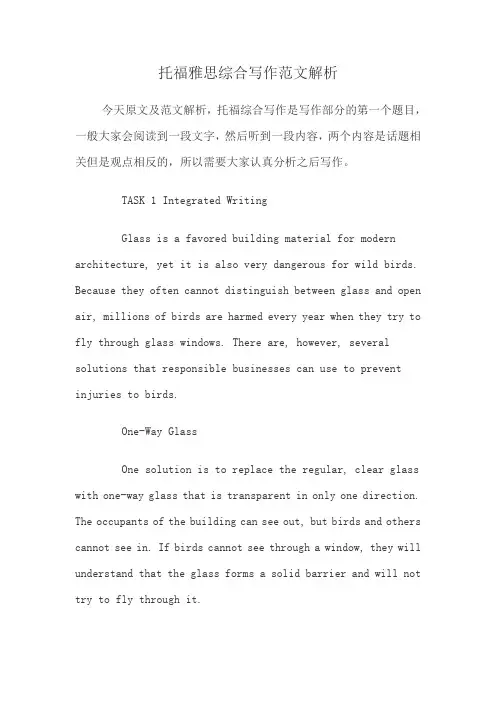
托福雅思综合写作范文解析今天原文及范文解析,托福综合写作是写作部分的第一个题目,一般大家会阅读到一段文字,然后听到一段内容,两个内容是话题相关但是观点相反的,所以需要大家认真分析之后写作。
TASK 1 Integrated WritingGlass is a favored building material for modern architecture, yet it is also very dangerous for wild birds. Because they often cannot distinguish between glass and open air, millions of birds are harmed every year when they try to fly through glass windows. There are, however, several solutions that responsible businesses can use to prevent injuries to birds.One-Way GlassOne solution is to replace the regular, clear glass with one-way glass that is transparent in only one direction. The occupants of the building can see out, but birds and others cannot see in. If birds cannot see through a window, they will understand that the glass forms a solid barrier and will not try to fly through it.Colorful DesignsA second solution is to paint colorful lines or other designs on regular window glass. For example, a window could have a design of thin stripes painted over the glass. People would still be able to see through the openings in the design where there is no paint, while birds would see the stripes and thus avoid trying to fly through the glass. Architects can be encouraged to include colorful painted patterns on glass as part of the general design of buildings.Magnetic FieldThe third solution is to create an artificial magnetic field to guide birds away from buildings. Humans use an instrument called a magnetic compass to determine directions —either north, south, east, or west. Bird research has shown that birds have a natural ability to sense Earth’s magnetic fields; this ability works just like a compass, and it helps birds navigate in the right direction when they fly. A building in a bird flight path can be equipped with powerful electromagnets that emit magnetic signals that steer birds in a direction away from the building.Now listen to part of a lecture on the topic you’ve just read about.None of the solutions you’ve read about will effectively stop birds from getting injured. First, replacing regular glass with one-way glass. Well, the problem withone-way glass is that to the bird on the outside, a one-way glass surface reflects just like a mirror. And a surface that reflects like a mirror is just as bad as regular glass for birds because birds don’t understand mirrors. If they see a reflection of the sky in a mirror or of a tree in the mirror, they think the reflection is the sky or is the tree and they’ll fly right into them.The second solution, painting colorful patterns like stripes on regular glass, also has problems. As the reading said, these designs include openings so people inside the buildings can see out. But birds will perceive these unpainted openings as open holes. And if birds think they’re seeing holes, they will try to fly right through them. To prevent birds from doing this, the unpainted spaces in the window would have to be extremely small. But that would then make the rooms of the buildings too dark for the people inside them.The third solution, creating an artificial magnetic field, won’t work very well, either. While it’s true that birds use Earth’s magnetic field to help them navigate, they use this only when they’re traveling very long distances. For example, if a bird is migrating from a cold country to a warm one during winter, it will use its magnetic sense to figure out which way it should fly. But this ability isn’t used to go over short distances such as going from one side to the city to another. For short trips, birds use their eyes and the brightness of light to determine where to go so magnetic signals from buildings won’t have much effect.Summarize the points made in the lecture. Be sure to explain how they cast doubt on the specific solutions proposed in the reading passage.DirectionsYou have 20 minutes to plan and write your response. Your response will be judged on the basis of the quality of your writing and on how well your response presents the points in the lecture and their relationship to the reading passage. Typically, an effective response will be 150 to 225 words.Essay TopicSummarize the points made in the lecture, being sure to explain how they cast doubt on the specific solutions proposed in the reading passage.You must finish your answer in 20 minutes本文是托福tpo42综合写作原文及范文解析。

托福综合写作范文真题解析.托福综合写作范文真题解析这些如果应对托福综合写作的听力内容和阅读内容?托福综合写作应该如何写?都是考生在备考时应该掌握的,这样才能在考试中为你的托福综合写作提分。
托福这里小站教育编辑就为大家带来了托福综合写作的真题解析,希望对大家写作提分有帮助。
这里小站教育名师用TPO29的托福综合写作为例为大家详解托福综合写作的解题全过程,希望对大家备考托福写作有帮助。
阅读内容:Large numbers of dinosaur fossils have been discovered in deposits on Alaska's North Slope, a region that today experiences an extremely cold, arctic climate. One hundred million years ago, when those dinosaurs were alive, the environment of the North Slope was already inhospitable, especially during the winter when it experienced several months of total darkness. How did the dinosaurs survive the wintertime? Paleontologists have proposed that one of the most common North Slope dinosaurs, the elephant-sized Edmontosaur (Edmontosaurus), survived the winter by migrating south to more hospitable regions. Several arguments support the migration hypothesis.现今经历极寒,拥有北极气候的阿拉斯加北坡,发掘出了大量恐龙化石。

4月23日托福写作答案解析4月23日托福综合写作Topic 议题:feeders are bad for birdsReadingListeningSub-point 1分论点1Birds gather easily, thus spreading diseases.The diseases that spread in Hinch are always group-by-group. It has nothing to do with humans.Sub-point2分论点2Birds are exposed to predators.If humans feed birds, extra nutrition will make them stronger and healthier,enhancing the speed of reproduction. The number of new-born birds will be larger than the number of dead birds.Sub-point3分论点3It 眀椀氀氀influence birds’migration pattern.It will not disturb the pattern of natural migration, because birds will depend on shortened sunlight to decide the migration time.Sample answer:The writer and the speaker have a debate on feeding bird during the winter. The writer believes it has negative influences on birds, which is opposed by the following lecture.First, the writer claims that birds gather easily, thus spreading diseases. While the speaker views this issue from an opposite angle, according to him/her, the diseases that spread in Hinch are always group-by-group. It has nothing to do with humans.Secondly, the passage states that bad weather results in shortage of food supply. However, the speaker casts doubt on this opinion by saying that if humans feed birds, extra nutrition will make them stronger and healthier, enhancing the speed of reproduction. The number of new-born birds will be larger than the number of dead birds.Last, the writer argues that it will influence birds’migration pattern. By contrast, in accordance with the speaker, this claim does not hold water. It will not disturb the pattern of natural migration, because birds will depend on shortened sunlight to decide the migration time.4月23日托福独立写作:作文题目:Do you agree or disagree with the following statement? Playing sports teaches people more important lessons about life.题型类别:同不同意类题材类别:事实类相关旧题:2010.12.19ML/2015.6.14ML写作思路:这道题是比较典型的事实类题目。
托福综合写作范文真题解析托福综合写作应该如何写?如果应对托福综合写作的听力内容和阅读内容?这些都是考生在备考时应该掌握的,这样才能在考试中为你的托福综合写作提分。
这里小站教育编辑就为大家带来了托福综合写作的真题解析,希望对大家托福写作提分有帮助。
这里小站教育名师用TPO29的托福综合写作为例为大家详解托福综合写作的解题全过程,希望对大家备考托福写作有帮助。
阅读内容:Large numbers of dinosaur fossils have been discovered in deposits on Alaska’s North Slope, a region that today experiences an extremely cold, arctic climate. One hundred million years ago, when those dinosaurs were alive, the environment of the North Slope was already inhospitable, especially during the winter when it experienced several months of total darkness. How did the dinosaurs survive the wintertime? Paleontologists have proposed that one of the most common North Slope dinosaurs, the elephant-sized Edmontosaur (Edmontosaurus), survived the winter by migrating south to more hospitable regions. Several arguments support the migration hypothesis.现今经历极寒,拥有北极气候的阿拉斯加北坡,发掘出了大量恐龙化石。
托福考试写作专项历年真题2024托福考试是世界各地许多学生申请海外大学的必备考试之一。
写作部分是托福考试的重要组成部分,考察考生的逻辑思维能力、语言表达能力以及写作结构能力。
下面将针对2024年的托福考试写作真题进行分析和解答。
1. 第一篇文章2024年托福考试写作真题的第一篇文章是关于人工智能对社会和工作的影响。
文章认为人工智能的发展将会带来工作机会的减少和不公平的分配问题。
然而,文章也指出人工智能的发展将带来效率的提高和创造更多新兴行业。
针对这篇文章,我们需要分析其观点,并进行适当的回应。
首先,可以在第一段简要概括文章内容。
然后,在接下来的段落中,可以对人工智能对工作机会的减少和不公平分配进行讨论,并提出自己的观点和论证。
最后,可以谈论人工智能对效率提高和新兴行业的积极影响,并进一步加以证明。
2. 第二篇文章托福考试写作2024年真题的第二篇文章是关于学生是否应该兼职工作的问题。
文章认为学生应该专注于学业,不应分散精力去兼职工作。
然而,文章也提到兼职工作可以培养学生的社会经验和实际能力。
对于这篇文章,我们需要对其观点进行分析。
首先,可以在第一段陈述文章的内容和观点。
接下来的段落中,可以对学生兼职工作对学生学业的影响进行讨论,并提出自己的观点和理由。
最后,可以讨论兼职工作对学生社会经验和实际能力的益处,并进一步说明。
3. 第三篇文章托福考试写作2024年真题的第三篇文章是关于环保问题的。
文章提出环保是全球性的重要议题,应该得到更多的关注和行动。
文章还指出环保问题的解决需要国际合作和政府领导。
对于这篇文章,我们需要对其观点进行分析并回应。
首先,可在第一段简要概括文章内容和观点。
接下来的段落中,可以探讨环保问题的重要性,并提出自己对于环保的看法和解决方案。
最后,可以谈论国际合作和政府领导的重要性,并给出相应的论据。
4. 第四篇文章托福考试写作2024年真题的第四篇文章是关于城市化对农村地区的影响。
2024托福考试写作历年题目综合解析托福考试(TOEFL)作为一项国际英语语言测试,对考生的写作能力有着较高的要求。
通过解析历年的托福考试写作题目,可以更好地了解考试的趋势和特点,并为备考提供参考。
本文将综合解析2024年托福考试的写作题目,帮助考生更好地准备考试。
【题目一】Do you agree or disagree with the following statement? People should spend more time interacting with nature. Use specific reasons and examples to support your answer.这个题目是要求对“人们应该花更多时间与大自然互动”这一论点发表观点,并给出理由和例子来支持自己的论述。
首先,我同意这个观点。
现代社会人们的生活节奏非常快,每天都过着忙碌的生活。
然而,与大自然互动不仅可以使人们放松身心,缓解压力,同时也有助于保护环境和增加生态平衡。
举个例子,如果人们花更多的时间与大自然互动,就会更加关注环境问题。
他们会更加珍惜自然资源,减少浪费,并采取积极的措施来保护环境,例如参加环保活动或者种植树木。
此外,与大自然互动可以使人们更好地欣赏自然的美丽和奇迹。
例如,当人们在大自然中散步时,可以欣赏美丽的风景、听鸟儿的歌唱和感受大自然的力量。
这些体验将使人们更加深刻地认识到自然的伟大和美好。
总的来说,与大自然互动对人们的身心健康和环境保护都有积极的影响。
因此,我认为人们应该花更多的时间与大自然互动。
【题目二】Do you agree or disagree with the following statement? It is better to have a small number of close friends than a large number of casual acquaintances. Use specific reasons and examples to support your answer.这个题目是要求对“拥有少数亲密朋友比拥有大量的泛泛之交更好”这一说法发表观点,并给出理由和例子来支持自己的论述。
托福0430综合写作一、阅读部分。
阅读文章讲了一个关于某种动物栖息地减少的事儿。
就说那个地方本来是这个动物特别美好的家呢。
那里有好多它们爱吃的东西,像那种小虫子啦,还有一些嫩嫩的草之类的。
而且那个栖息地的环境特别适合它们生存,温度啊,湿度啊,都刚刚好,就像为它们量身定制的小窝一样。
可是呢,现在这个栖息地在不断缩小。
主要原因就是人类的活动啦。
人类在那里搞建设,盖房子呀,建工厂呀。
那些大机器轰隆隆的,一下子就把动物们的家给破坏了。
而且人类还会在那里种一些不是本地的植物,这些外来植物可霸道了,把原来动物们吃的那些植物的生存空间都给抢了,搞得那些小动物们都没东西吃了。
还有哦,人类的一些污染行为也对这个栖息地影响很大。
比如说乱排污水,那些脏水把小动物们喝水的地方都给污染了,它们要是喝了那些脏水,肯定会生病的。
这就好像我们人类要是喝了不干净的水,也会肚子疼一样呀。
二、听力部分。
听力里面就不同意阅读的观点啦。
听力里说虽然看起来栖息地是在减少,但是实际上有很多保护措施在进行呢。
比如说有一些专门的保护组织,他们可热心了,一直在努力保护这个栖息地。
这些组织会在栖息地周围设置一些保护区域,不让那些破坏环境的人随便进去。
而且关于那些外来植物的问题,也不是像阅读里说的那么严重。
其实当地政府已经意识到这个问题了,他们采取了一些措施来控制外来植物的生长。
比如派专人去清理那些外来植物,然后再种上本地的植物,这样就又能给小动物们提供食物啦。
还有那个污染的事儿,也有改善的情况哦。
现在有很多新的环保技术,工厂也开始重视这个问题了,他们会处理污水之后再排放。
并且当地居民也很配合,大家都知道这个栖息地对小动物们很重要,所以都在努力减少污染,像不乱扔垃圾之类的。
三、对比分析。
从阅读和听力的内容来看,差别还挺大的呢。
阅读就一直在强调栖息地在减少,都是人类的错,把情况说得特别糟糕。
但是听力呢,就比较乐观,它看到了很多积极的方面,像保护组织的努力、政府的措施还有大家环保意识的提高。
2024托福考试写作历年真题全面解析Introduction:托福考试自1979年开始,至今已有超过45年的历史。
对于想要参加托福考试的考生来说,了解历年真题是非常重要的。
通过解析历年真题,考生们可以更好地了解考试内容和要求,提升自己的备考效果。
本文将对2024年托福考试的写作部分历年真题进行全面解析。
Section 1: Integrated WritingIntegrated Writing是托福写作考试的第一部分,要求考生综合阅读和听力材料,然后从中提取关键信息进行综合写作。
以下是2024年托福写作部分历年真题的解析。
题目一:The importance of preserving historical sites阅读材料:历史遗址的保护和传承对于一个国家的文化和历史意义重大。
听力材料:不同观点的对比,一方认为重建历史遗址可以更好地展示历史,另一方认为保留原貌更能体现真实性。
解析:这个题目讨论了保护历史遗址的重要性。
考生可以首先简要概括阅读和听力材料的主要内容,然后比较两种观点,最后给出自己的观点。
题目二:The impact of social media on interpersonal relationships阅读材料:社交媒体在现代社会中的普及对人们的日常交流和人际关系产生了重要影响。
听力材料:社交媒体给人们带来了更多交流的机会,但也导致人们面对面的交流减少。
解析:这个题目讨论了社交媒体对人际关系的影响。
考生可以首先简要概括阅读和听力材料的主要内容,然后比较两种观点,最后给出自己的观点。
Section 2: Independent WritingIndependent Writing是托福写作考试的第二部分,要求考生独立思考,提供自己的观点和理由。
以下是2024年托福写作部分历年真题的解析。
题目一:Is it better to study alone or in a group?解析:这个题目讨论了独立学习和集体学习的优缺点。
新托福综合写作真题完整解析分享新托福综合写作真题完整解析分享托福综合写作原文:Throughout the Greek islands, archaeologists have found over 200 plate-sized ceramic disks dating to about 2022 to 3000 B.C.E. The disks are typically decorated on one side, while the other side is undecorated and has a raised edge that creates a shallow basin. They usually also have short handles. Archaeologists are still unclear about what the objects were used for. Three theories about their function have been proposed.Pans for Cooking FoodSome archaeologists believe that the objects were used for cooking food. These archaeologists believe that food was placed on the undecorated side and that the raised edge on that side prevented the food from falling out of the pan. The handle would have made it easier and safer to remove the pan from a cooking fire or oven.DrumsOther archaeologists believe that the objects were drums for making sounds. These archaeologists point out that animal skins could have been stretched over the side with the raised edge, creating an air chamber that would have amplified sound when the animal skin was struck. According to this theory, the person doing the drumming would hold the drum by the handle with one hand and strike the skin with the other hand.MirrorsYet other archaeologists believe that the objects were a kind of ancient mirror. Although the objects are not made of a reflective material, they could have been used to create a reflection by pouringa liquid, such as olive oil, into the shallow basin with the raised edge. Supporters of this theory point out that the decorations found on the ceramic disks are similar to decorations found on hand-held metal mirrors made in ancient Greece.Directions: You have 20 minutes to plan and write your response. Your response will be judged on the basis of the quality of your writing and on how well your response presents the points in the lecture and their relationship to the reading passage. Typically, an effective response will be 150 to 225 words.阅读:出土了一种用陶土做的disk,一面有花纹,一面没花纹。
托福综合写作范文真题解析托福综合写作应该如何写?如果应对托福综合写作的听力内容和阅读内容?这些都是考生在备考时应该掌握的,这样才能在考试中为你的托福综合写作提分。
这里小站教育编辑就为大家带来了托福综合写作的真题解析,希望对大家托福写作提分有帮助。
这里小站教育名师用TPO29的托福综合写作为例为大家详解托福综合写作的解题全过程,希望对大家备考托福写作有帮助。
阅读内容:Large numbers of dinosaur fossils have been discovered in deposits on Alaska’s North Slope, a region that today experiences an extremely cold, arctic climate. One hundred million years ago, when those dinosaurs were alive, the environment of the North Slope was already inhospitable, especially during the winter when it experienced several months of total darkness. How did the dinosaurs survive the wintertime? Paleontologists have proposed that one of the most common North Slope dinosaurs, the elephant-sized Edmontosaur (Edmontosaurus), survived the winter by migrating south to more hospitable regions. Several arguments support the migration hypothesis.现今经历极寒,拥有北极气候的阿拉斯加北坡,发掘出了大量恐龙化石。
一亿年以前,当这些恐龙依然存活的时候,北坡环境就已然不宜生物居住了,尤其在冬季,北坡经历着长达数月的黑暗。
当时的恐龙是如何在那里的冬季生存下来的?以当时最常见的北坡恐龙——一种大象般大小的埃德蒙顿龙为例,古生物学家做出了如此假设:埃德蒙顿龙依靠迁徙至南部更宜居的区域来度过北坡的冬季。
对于以上假说,有如下几点论据。
First, the Edmontosaur diet supports the migration hypothesis. Edmontosaurus fed exclusively on plants. Since there would have been no plants growing during the cold and dark North Slope winter, it appears that the Edmontosaur must have left for at least part of the year and migrated to more temperate zones to find food.首先,埃德蒙顿龙的食谱支持了迁徙说。
埃德蒙顿龙仅以植物为食。
由于在寒冷而黑暗的冬天,北坡并无植物生长,埃德蒙顿龙势必在一年中的部分时间离开北坡,迁徙至更温暖的区域觅食。
Second, many Edmontosaur skeletons have been unearthed from the same site. This suggests that Edmontosaurs lived in herd. Many modern-day migratoryanimals, such as caribou and buffalo, live and migrate in herds as well. Moving in herds helps animals coordinate their migration. The finding that Edmontosaurs lived in herds further supports the migration hypothesis. 第二,许多埃德蒙顿龙骨架在相同的地点被发掘出了。
这显示埃德蒙顿龙属于群居生物。
许多现今存在的迁徙动物,比如驯鹿和水牛,也是成群结队迁徙的。
成群移动能够帮助动物们在迁徙过程中更加协调一致。
埃德蒙顿龙属群居动物这一发现,支持了迁徙说。
Finally, Edmontosaurs were physically capable of migrating long distances. To reach more hospitable regions, the Edmontosaur had to migrate about 1,600 kilometers southward. To make such a journey, the Edmontosaur needed to move at about five kilometers per hour for several weeks, which certainly could do. These animals could run very fast, reaching speeds up to 45 kilometers per hour. It could have easily used its locomotive power to move to warmer climate during the harsh arctic winter.最后,埃德蒙顿龙的生理构造能够支持它们的长途迁徙。
为了到达更加宜居的区域,埃德蒙顿龙必须朝南迁移1600公里。
为了完成这一旅程,埃德蒙顿龙需要以每小时5公里的速度奔徙数周,当然,这些对于它们而言都不是事儿。
埃德蒙顿龙奔跑的速度很快,接近每小时45公里。
在严酷的北极冬季里,埃德蒙顿龙可以轻易地凭借其移动能力迁至温暖的气候环境中去。
听力内容:The hypothesis that the Edmontosaur migrated every winter is not convincing.First, the Edmontosaur did not have to migrate to find food. One hundred million years ago, the summer temperatures in the North Slope area were warmer than they are today. And remember, in arctic regions like the North Slope, the Sun shines 24 hours a day at the peak of the summer. The warm temperatures and extensive daylight created incredibly good growing conditions for plants, so much vegetation was produced during the summer that when the vegetation died as the winter came, there was a lot of nutritious dead vegetation around in the winter. The Edmontosaur could have easily lived on the dead plant matter during the winter. Second, just because Edmontosaurs lived in herds doesn’t mean they migrated. Animals live in herds for many other reasons. Living in herds, for example, provides animals with extra protection from predators.Having extra protection is useful even for the animals that live in the same area the whole year around. A modern example of this is the Roosevelt elk—a large plant-eater. Roosevelt elks live in the forests of the western United States. They live in herds but they do not migrate. Third, although adult Edmontosaurs were capable of migrating long distances, what about Edmontosaurs that were not yet adults? Juvenile Edmontosaurs were not physically capable of travelling the great distances required to reach warmer territories and would have slowed the herd so much that the herd never would have made it to its destination. The herd could not have left the juveniles behind because the juveniles would not have survived on their own. So the whole herd had to stay where they were and survive on the cold North Slope.满分范文分享:In the reading passage, the writer claim that Edmontosaurus had to migrate to hospitable places in the south, if they want to survive in the cold weather. The speaker, however, contradicts this view for the following three reasons.First of all, the reading materials points out that it is difficult that Edmontosaurus can find food in cold winter because they were fed on plants exclusively. But the speaker refutes that warm weather in summer supplied perfect condition for plants to grow. So Edmontosaurus might found lots of nutritious dead vegetation around in the winter, which made migration unnecessary.Second, unearthed skeletons from the same site indicated that Edmontosaurus lived in herds. Living in herds made migration much easy. But the lecture gives an example of Roosevelt elks to prove that group living might have various types of reasons. Edmontosaurusmay live in herds in order to seek for extra protection. So living in herds could not provide evidence for migration claim.Lastly, Edmontosaurus, in view of the writer, had the ability oflong-distance movement. Although the lecturer admitted the locomotive capability of Edmontosaurus, she points out that juvenile Edmontosaurus were lack of such ability. So the herd would not leave juneniles behind in the North Slope, which strongly refutes the author’s claim.用到的词汇/词组migrate随季节而移动,移居hospitable环境舒适的exclusively仅仅,唯一地nutritious有营养地vegetation植被,植物live in herd群居juvenile青少年的arctic climate北极气候inhospitable不宜居住的hypothesis假设deposit沉积物unearth发掘at the peak of在…高峰期migratory迁徙的buffalo水牛caribou北美驯鹿coordinate使协调,配合predator捕食者feed on plant以植物为食Roosevelt elk罗斯福麋鹿temperate温和的leave…behind留下,丢弃territory领地,地域be capable of 能够live on 以…为食elephant-sized 庞大的综合写作语法知识讲解:1.The speaker, however, contradicts this view for the following three reasons.翻译:听力中的教授,然而,却用如下三个原因对这个观点进行了反驳。